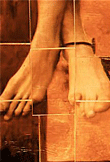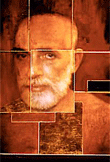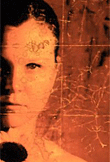
Behold 1996, Photowork 22ct gold leaf on paper, 120x80cm

Gordon 1996, Photowork 22ct gold leaf on paper, 120x80cm

Hanna & Sunflower,1996, C- Type Photo, 120x80cm
Artist-in-residence Project, St Vincent’s Hospital, 1995
Maree Azzopardi has spent six months as an artist-in-residence at St Vincent’s Hospital working with people living with HIV and AIDS. Her project to work with NESB male and female patients of this hospital was assisted by a grant from the Sydney Gay and lesbian Mardi Gras. These paintings and Polaroid collages are the result of her residency.
For the first time Maree Azzopardi has produced a catalogue and in part this is an acknowledgement of her increasing confidence as an artist. It is also a reflection of the emotional impact that this project has had upon her and the meaning this project has for the other people involved. The exhibition is titled The Chrysalis. Maree Azzopardi feels that in any crisis such as society is experiencing with AIDS something positive must emerge. Hence her idea of a chrysalis as a stage before a new life. To affirm the possibility of a new life beyond death the participants need some documentation to be accessible after this exhibition has ended.
In the beginning of her residency Maree found no one wanted to become part of her project because they were frightened to be exposed or shown in a public forum. Gradually some patients visited her. Now there is a desire by those who have become involved in the project for her images to become the means of immortalizing themselves. One of her subjects has waited for the particular painting of himself to be completed before he died.
The patients initial reticence to participate can be seen as a response to negative perceptions in the outside world towards people living with HIV and AIDS. The hospital often acts as a refuge from intolerance in the community at large where many people are hostile. These people believe that those who are HIV positive or who have contracted AIDS and have been infected through drug use or homosexual sex are being punished for their lifestyle. The sympathy and support offered to cancer sufferers or those ‘innocent’ victims who contracted AIDS through blood transfusions is denied these sinners. As Simon Watney points out
Reading AIDS as the outward and visible sign of an imagined depravity of will, AIDS commentary deftly returns us to a pre-modern version of the body, according to which heresy and sin are held to be scored in the features of their voluntary subjects by punitory and admonitory manifestations of the disease.1
One strategy for countering this ‘pre-modern’ version is to present these subjects not as sinners but as ‘saints’ or ‘martyrs’ who in transcending the flesh have found redemption through their suffering. As Maree Azzopardi has always had an interest in iconography and her work has been strongly influenced by Catholic religious imagery one subject asked Maree to ‘make me like something in the Sistine Chapel’. For people living with HIV and AIDS every day life can be filled with the experience of physical change and pain which offers little opportunity for dealing with spiritual dimensions. By seeing their dying glorified through Maree Azzopardi’s images they feel immortalized.
The media has frequently been sentimental, sensationalist or exploitative in imaging AIDS.2 These works by Maree Azzopardi are powerful statements of the cathartic search by the artist and her subjects to find meaning through imaging AIDS. Such exhibitions can powerfully engage the viewer and confront them with the continuing tragedy of so many interrupted lives.
By approaching her project with a post-modernist consciousness and through working with subjects who are male and female, straight and gay, Anglo and NESB her images stress our affinity rather than difference. Perhaps projects such as this will help establish political alliances between those who are also other and different.3
Professor Liz Asburn, 1996
College of Fine Arts, University of New South Wales
1.Simon Watney, The Spectale of AIDS, October, 43, Winter, 1987, pp.71-86
2. Simon Watney, Art from the Pit: Some Reflections on Monuments, Memory and AIDS, in Don’t Leave Me This Way: Art in the Age of AIDS, National Gallery, Canberra, 1994, pp52-63.
3.Anna maria Alonso, Maria Teresa Koreck Silences, “Hispanics’, AIDS and Sexual Practices differences; a Journal of Feminist Cultural Studies, 1.1, Winter, 1989, p. 102-124
